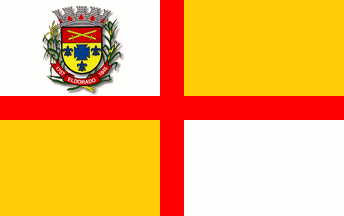 image by Dirk Schönberger,
24 October 2012
image by Dirk Schönberger,
24 October 2012Source: http://www.eldorado.sp.gov.br/cidade/simbolos-oficiais

Last modified: 2012-11-10 by ian macdonald
Keywords: sao paulo | eldorado |
Links: FOTW homepage |
search |
disclaimer and copyright |
write us |
mirrors
 image by Dirk Schönberger,
24 October 2012
image by Dirk Schönberger,
24 October 2012
Source:
http://www.eldorado.sp.gov.br/cidade/simbolos-oficiais
Quartered by a red cross, white-gold-gold-white, with the municipal arms in the canton quarter.
Official website at
http://www.eldorado.sp.gov.br
Dirk Schönberger,
24 October 2012
Eldorado originates in the settlement of Xiririca, which emerged around 1750 near the river of the same name, a tributary of River Ribeira. On 16 January 1757, the Veras, one of the most important colonists in the region, offered two houses to build a chapel in the settlement; on 8 September, the chapel was granted a statue of Our Lady of Guia, soon the patron saint of the village. Xiririca originally belonged to the town of Iguape. The parish of Xiririca was established on 13 January 1763. Two floods severely damaged Xiririca on 19 January 1807 and 28 January 1809. After years of discussion and controversy, the village was progressively (1816-1934) moved to the Formosa Port, a higher place located 2 km downstream from the old village. The parish of Xiririca was made a town - that is, at the time, a municipality - on 10 March 1842 by State Law No. 28, which was inaugurated on 2 May 1845. On 2 March 1857, the steamboat "Estrela" reached Xiririca, which inaugurated a period of commercial prosperity. The power plant built on river Ribeira was one of the first in the State, supplying electricity to the town until 1962. Its inauguration (1926) was tragic: the engineer Nuno Silva attempted a last minute repair short before the inauguration; he was electrocuted when power was switched on and died a few days later in Santos. Xiririca was renamed Eldorado Paulista on 24 December 1948, as a reference to the Gold Rush that started in the region around 1630 and boosted the first wave of colonization. Eldorada was preferred to other proposals, such as Miraluz, and Formosa do Ribeira.
Eldorado (then Xirica) is the birth place of the poetess Francisca Júlia da Silva Munster (1871-1920). She moved early to São Paulo, where she became a noted journalist and writer, which was quite unexpected for a woman at the time. Olavo Bilac (1865-1918), one of the founders of the Brazilian Academy of Letters, enjoyed her poetry as "a marvellous bath of novelty and freshness". She committed suicide tow days after the death of her husband from tuberculosis.
In 1886, the German explorer and naturalist Ricardo Krone discovered the Tapagem Cave, subsequently renamed Devil's Cave, a main tourist's spot in São Paulo State, included in the Devil's Cave State Park. On 1 August 1995, Eldorado was granted the title of Tourist Resort, which explains why the town is self-styled "Estância Turística de Eldorado" - which is not the official name of the municipality, though.
The symbols of Eldorado, designed by Lauro Ribeiro Escobar, are prescribed by Law No. 132 of 18 September 1975.
The flag is described in Articles 5-6 of the Law. The flag is quartered white-yellow by a red cross, with the municipal arms added in the first quarter. The flag shall be in size 14 units x 20 units. The size on the coat of arms shall be 3 units x 4.5 units. The width of the cross is not specified.
The coat of arms and its use are prescribed in Articles 2-4 of the Law. " Rounded-off shield, or with three fleurs-de-lis azure surrounding a cross patty of the same, a chief gules charged with two Roman swords or crossed per saltire. The shield surmounted by a mural crown argent of eight towers port and windows gules. The shield supported dexter by a plant of rice and sinister by a plant of maize, the two fructed. Below the shield a scroll gules inscribed with the toponym 'ELDORADO' surrounded by the years '1767' and '1845', all or."
The rounded-off shield, used at the time of the discovery of Brazil, evokes the first colonists of the country. Or means wealth, splendour, glory, nobleness, power, force, faith, prosperity, sovereignty and rule, it also recall the auriferous veins that attracted Romão Pereira Veras, Severino Pereira Veras Filho, Antonio Pereira Veras and Fausto Pereira Veras, the early colonists of the region. The cross recalls the chapel dedicated to Our Lady of Xiririca, erected in 1757 by Romão and Severino Pereira Veras. The fleurs-de-lis represents the patron saint of Eldorado, Our Lady of Guia. Azure (blue) represents in heraldry justice, beauty, sweetness, nobleness, incorruptible firmness, virtue, dignity, zeal and loyalty, characteristic of the inhabitants of the administrators of the municipality in their search for progress. The swords recall the contribution of Eldorado to the Constitutionalist Revolution of 1932 (aka Paulista War). The sword is also the symbol of war and justice. Gules (red) represents in heraldry audacity, valor, intrepidity, honour, nobleness, and blood shed in fighting. The mural crown is the symbol of municipalities. The open gates emphasize the hospitality of the inhabitants of the town, while their red colour represents Law and Justice. The rice and maize plants represent the soil fertility and a main source of income. The year "1757" recalls the erection of the first chapel, while the year "1845" recalls political emancipation.
http://www.eldorado.sp.gov.br/cidade/simbolos-oficiais/500-bandeira-da-estancia-turistica-de-eldorado - Municipal website
Photo of the flag (2011):
http://www.eldorado.sp.gov.br/galeria-imagens/aniversario-de-eldorado/5-aniversarioeldorado169/detail/212-dsc0275?tmpl=component
Ivan Sache, 1 November 2012